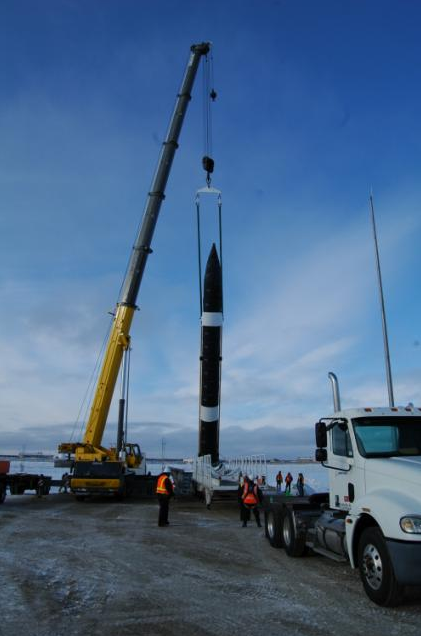The standard answer is about $70 million each, but the actual cost is more like $90+ million. And the GBI unit acquisition cost, which includes development costs, is well in excess of $400 million each.
.A GBI being deployed into a silo at Fort Greely, February 2012 (Photograph source: www.mda.mil/global/images/system/gmd/DSC_5160.jpg).
The Ground-Based Interceptor (GBI) is the interceptor for the U.S. Ground-Based Midcourse Defense (GMD) national ballistic missile defense system. Currently 30 GBIs are deployed in silos, 26 in at Fort Greely in Alaska and 4 at Vandenberg Air Force Base in California. An additional 14 silos in Alaska are available, but there are currently no public plans to fill them.
It is difficult to find precise figures for GBI costs, because their costs are lumped together with other elements of the GMD such as its command and control infrastructure. In addition, there are two different versions of the GBI’s homing Exoatmospheric Kill Vehicle (EKV) deployed, and the MDA has not separately reported on the costs of GBIs armed with the different versions of the EKV.
For the last few years, the standard cost figure for a GBI has been about $70 million. This was the figure used in October 2009 by General James Cartwright, Vice Chair of the Joint Chiefs of Staff, in arguing that the SM-3 interceptors planned for the newly announced European Phased Adaptive Approach (EPAA) system were much cheaper than GBIs.[1] In April 2011, it was the figure used by Missile Defense Agency (MDA) Director Lt. General Patrick O’Reilly in assessing the cost of a GMD test.[2] Later in 2011, a Defense Science Board Report noted that the MDA had “had provided an approximate estimate of $70 million per GBI.”[3]
These relatively vague figures, however, almost certainly do not include the extensive additional costs required to refurbish already deployed interceptors and to fix problems revealed by test failures. In 2007 the MDA began a program, which is still ongoing, to refurbish older GBIs equipped with the original Capability Enhancement I (CE-I) version of the EKV. According to a 2012 GAO report, this refurbishment process was expected to “continue for many more years” and to cost between $14 and $24 million.[4]
Similarly, the ten already deployed GBIs with the new CE-II version of the EKV will need to be retrofitted to address the problem that caused the failure of a test intercept in December 2010. Although the cost to do this has not yet been determined, MDA officials told the GAO they expected this to cost about $18 million for each CE-II EKV.[5]
Thus simply adding in the cost of these refurbishments and repairs brings the price of a GBI to about $90 million. Moreover, since every flight test of the operationally-configured GBI has identified problems that required a software or hardware fix (see post of May 21, 2012), it is reasonable to expect that there will be a continuing need for expensive modifications to the GBIs.
This $90 million figure is basically the cost to buying recent GBIs, without the large costs involved in developing the interceptors being factored in. If one includes these costs, according to the GAO the current program unit acquisition cost (which it defines as “the development, production deployment and military construction costs divided by the number of operationally configured units) for the GBI program was, as of February 2011, $421 million and likely still increasing.[6]
The total cost of the GMD program so far? $39.16 billion, according to GAO’s 2012 Assessments of Selected Weapon Programs.[7] This is just for the GBIs and their fire control system and does not include, for example, the radars that would detect and track targets.
[1] General James E. Cartwright, Prepared Statement, House Armed Services Committee, October 1, 2009.
[2] Hearing of the Strategic Forces Subcommittee of the Senate Armed Services Committee, “Ballistic Missile Defense Policies and Programs in Review of the Defense Authorization Request for Fiscal Year 2012 and the Future Years Defense Program,” April 13, 2011.
[3] Defense Science Board, “Science and Technology Issues of Early Intercept Ballistic Missile Defense Feasibility,” September 2011. Available at: http://www.acq.osd.mil/dsb/reports/ADA552472.pdf.
[4] U.S. Government Accountability Office, “Missile Defense: Opportunity Exists to Strengthen Acquisitions by Reducing Concurrency,” GAO-12-486, April 2012, p. 78. Available at: http://www.gao.gov/assets/600/590277.pdf.
[5] GAO, “Missile Defense: Opportunity Exists,” p. 78.
[6] GAO, “Missile Defense: Opportunity Exists,” pp. 75-76.
[7] Government Accountability Office, “Defense Acquisitions: Assessments of Selected Weapon Programs,” GAO-12-400SP, March 2012, p. 57. Available at: http://www.gao.gov/assets/590/589695.pdf.
